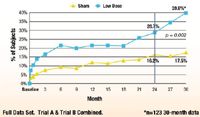Article
Novel steroid product promising for diabetic macular edema
Primary readout results from 24 months of follow-up in the pivotal phase III fluocinolone acetonide in diabetic macular edema studies demonstrate that a novel investigational corticosteroid-releasing intravitreal insert provides rapid and sustained improvement in visual acuity and macular swelling with an acceptable safety profile.

On June 29, Alimera Sciences announced it had submitted a new drug application to the FDA for approval of its intravitreal fluocinolone acetonide insert (FA insert) in treating diabetic macular edema (DME) with a request for priority review. The FA insert is a non-bioerodable cylindrical tube that is inserted through a self-sealing wound using a 25-gauge injector system.
"The pivotal trial data are very encouraging as they indicate the intravitreal FA insert is an exciting new tool to treat DME," said Dr. Ciulla, a FAME investigator and vitreoretinal specialist in private practice, Midwest Eye Institute, Indianapolis, IN. "The efficacy is very positive. Patients in the active treatment groups benefited with rapid and sustained improvements in best-corrected visual acuity (BCVA) and macular edema, even though the inclusion criteria and baseline clinical characteristics suggest they may represent a more difficult group on average, and the complication rate is reasonable and acceptable."

Patients were eligible to be enrolled in the study if they had a central retinal thickness greater than 250 µm measured by time-domain optical coherence tomography (OCT), BCVA >19 and <68 letters, and had received at least one macular laser treatment 12 weeks prior to screening.
At baseline, the study population had a mean duration of DME exceeding 3.5 years, mean BCVA of about 53 letters, and mean center point foveal thickness >450 µm; mean HbA1c was 7.8%, and 15.4% of patients had previously been treated with intravitreal steroid injections.
"The patients enrolled in FAME are not a typical group of previously untreated patients, but rather may represent those [either whose disease is] refractory to previous treatment or [who] have developed recurrent edema," Dr. Ciulla said. "If the FA insert is approved, the results achieved with it may be even better than those observed in the pivotal trials."
The functional data showed visual acuity rapidly improved after implantation of the FA intravitreal insert, and by 1 week, there was already a statistically significant difference between patients receiving the FA insert and the control group in the mean reduction from baseline foveal thickness. Efficacy was not dose-related, and with data pooled for all patients who received the FA insert, the results showed that by 3 months, more than 15% of corticosteroid-treated patients already had achieved a 3-line or greater improvement from baseline BCVA. By 6 months the proportion rose to 20%, and it remained stable at that level through 18 months, rising again at month 21.
The percentage of patients who achieved a 3-line or greater improvement in BCVA from baseline to 24 months was analyzed as the primary efficacy endpoint, and the data analysis showed a statistically significant difference favoring treatment with the FA insert versus sham injection (29% versus 16.5%; p = 0.002). Follow-up is continuing, and although only about one-third of study patients have been seen at 30 months, BCVA was improved by at least 3 lines from baseline in almost 40% of patients in the FA insert group compared with 17.5% of controls.
"The intravitreal corticosteroid accelerates cataracts, and about two-thirds of the enrolled patients were phakic at baseline," Dr. Ciulla said. "The early benefit of BCVA improvement reflects the activity of the corticosteroid for treating DME, while the trend for a later improvement is related to removal of cataracts."
Newsletter
Don’t miss out—get Ophthalmology Times updates on the latest clinical advancements and expert interviews, straight to your inbox.





